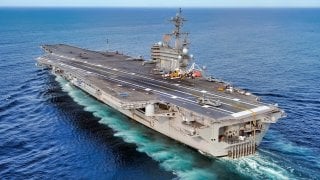Harrison Kass

Summary: Critics argue that the era of the aircraft carrier, a cornerstone of U.S. naval warfare and power projection for nearly eighty years, may be ending due to evolving defense technologies. Modern threats like submarines, surface vessels, and especially hypersonic missiles, which the U.S. currently lacks defenses against, pose significant risks to these expensive vessels. Despite their iconic status and ability to project airpower globally, the growing capabilities of potential adversaries like China question the aircraft carrier's future viability. This shift reflects a broader pattern in military history, where advances in warfare render previous dominant technologies obsolete.
Some pundits are calling for the United States to stop investing in their aircraft carrier fleet. Why? Because, as the argument goes, the age of the aircraft carrier is over; defense systems have evolved to the point where the aircraft carrier is a vulnerability.
A multi-billion-dollar vulnerability.
While the modern supercarrier costs many billions of dollars (the new Ford-class costs $13 billion per unit), the vessel is susceptible to relatively inexpensive weapons. Submarines. Surface Vessels. Hypersonic missiles. All can pick off an aircraft carrier. And in today’s shifting geopolitical climate, where the US and China seem to be trending towards a bipolarity, the viability of the US’s naval fleet is increasingly important.
Times change for Aircraft Carriers and the U.S. Navy
The aircraft carrier has been the seminal vessel, the most iconic boat, in naval warfare for nearly eighty years. Bursting into prominence during World War II, the aircraft carrier is a staple of US strategy – and the most recognizable type of boat in the fleet. The aircraft carrier confers prestige, and inspires awe, as a floating airbase capable of projecting airpower, and operating indefinitely, around the world.
Yet, the era of the aircraft carrier may be ending. It’s not so unusual. Military technological-related eras end. Warfare and weapons systems are constantly evolving. Meaning certain systems are constantly becoming outdated. Horse backed cavalry became outdated. Bow and error. Catapult. Musket. B-2 stealth bomber. Even the F-22 Raptor. More to the point, the era of the battleship came and went.
Battleships were to the end of the nineteenth century and first half of the twentieth century what aircraft carriers have been for the last several decades: the seminal vessel. Battleships commanded immense resources and immense respect, conferring prestige and inspiring awe. But as warfighting changed, the battleship faded into obscurity. Battleships were too slow. The massive firepower more difficult to concentrate in the face of a nimble enemy.
During World War II, the battleship era gave way to the aircraft carrier era, by way of necessity. The aircraft carrier was able to unleash a more articulate and tailored offensive (legions of aircraft) than the massive guns of the battleship. No one has ever looked back.
But now the aircraft carrier era may be concluding.
Is the Aircraft Carrier Obsolete? Depends on the Situation
Whether the aircraft carrier is obsolete is debatable.
Really, the answer depends upon the application of the aircraft carrier. Perhaps, the scope of application is narrowing, as advanced nations develop countermeasures capable of mitigating or sinking an aircraft carrier. And if the scope of application is narrowing, say, a US supercarrier might struggle to survive a conflict against China, then the US may want to reconsider funding an entire line of Ford-class carriers. But at present, US foreign policy is still built upon the application of aircraft carriers to project power abroad.
Using aircraft carriers is still plausible in certain regions where the US wishes to project power – the Middle East, for example. But concerns are increasing that in the Indo-Pacific a US aircraft carrier may be outmatched.
At present, China possesses hypersonic missiles. And at present, the US does not have a method for defending against hypersonic missiles.
Yet, the threats to aircraft carriers are less dramatic than super-modern hypersonic missiles. Submarines present a risk, too – as the US learned during war games with the French Rubis-class submarines (which managed to successfully “sink” the USS Theodore Roosevelt).
No comments:
Post a Comment